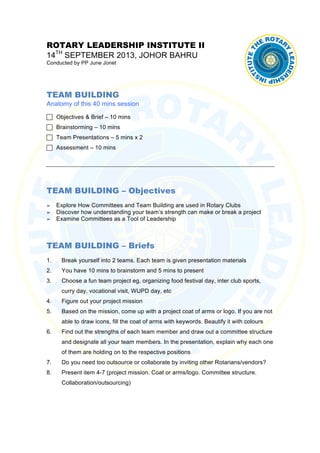
Rli team building assessment JJ
- 1. ROTARY LEADERSHIP INSTITUTE II 14TH SEPTEMBER 2013, JOHOR BAHRU Conducted by PP June Jonet TEAM BUILDING Anatomy of this 40 mins session Objectives & Brief – 10 mins Brainstorming – 10 mins Team Presentations – 5 mins x 2 Assessment – 10 mins TEAM BUILDING – Objectives ➢ Explore How Committees and Team Building are used in Rotary Clubs ➢ Discover how understanding your team’s strength can make or break a project ➢ Examine Committees as a Tool of Leadership TEAM BUILDING – Briefs 1. Break yourself into 2 teams. Each team is given presentation materials 2. You have 10 mins to brainstorm and 5 mins to present 3. Choose a fun team project eg, organizing food festival day, inter club sports, curry day, vocational visit, WUPD day, etc 4. Figure out your project mission 5. Based on the mission, come up with a project coat of arms or logo. If you are not able to draw icons, fill the coat of arms with keywords. Beautify it with colours 6. Find out the strengths of each team member and draw out a committee structure and designate all your team members. In the presentation, explain why each one of them are holding on to the respective positions 7. Do you need too outsource or collaborate by inviting other Rotarians/vendors? 8. Present item 4-7 (project mission. Coat or arms/logo. Committee structure. Collaboration/outsourcing)
- 2. ROTARY LEADERSHIP INSTITUTE II 14TH SEPTEMBER 2013, JOHOR BAHRU Conducted by PP June Jonet TEAM BUILDING – ASSESSMENT Let’s review…. 1. How was the team leader chosen? Was a team leader necessary? 2. How was the team spokesperson chosen? 3. What are the different strengths brought to the table by various team members? 4. What special talents did any team member have that helped the process? 5. How did you come up with the committee structure? 6. How collaborative was the group effort, or did one or two people decide? 7. Did everyone agree on the project mission? Were there conflicts? 8. How were the different symbols, colors and design of the project coat of arms agreed upon? 9. How did the time element play in the final decisions that were made? 10. What could the team have done to become more effective in its final product? 11. How does this exercise relate to committee or team activities at the club level? Your Notes ____________________________________________________________________ ____________________________________________________________________ ____________________________________________________________________ ____________________________________________________________________ ____________________________________________________________________ ____________________________________________________________________ ____________________________________________________________________ ____________________________________________________________________ ____________________________________________________________________
